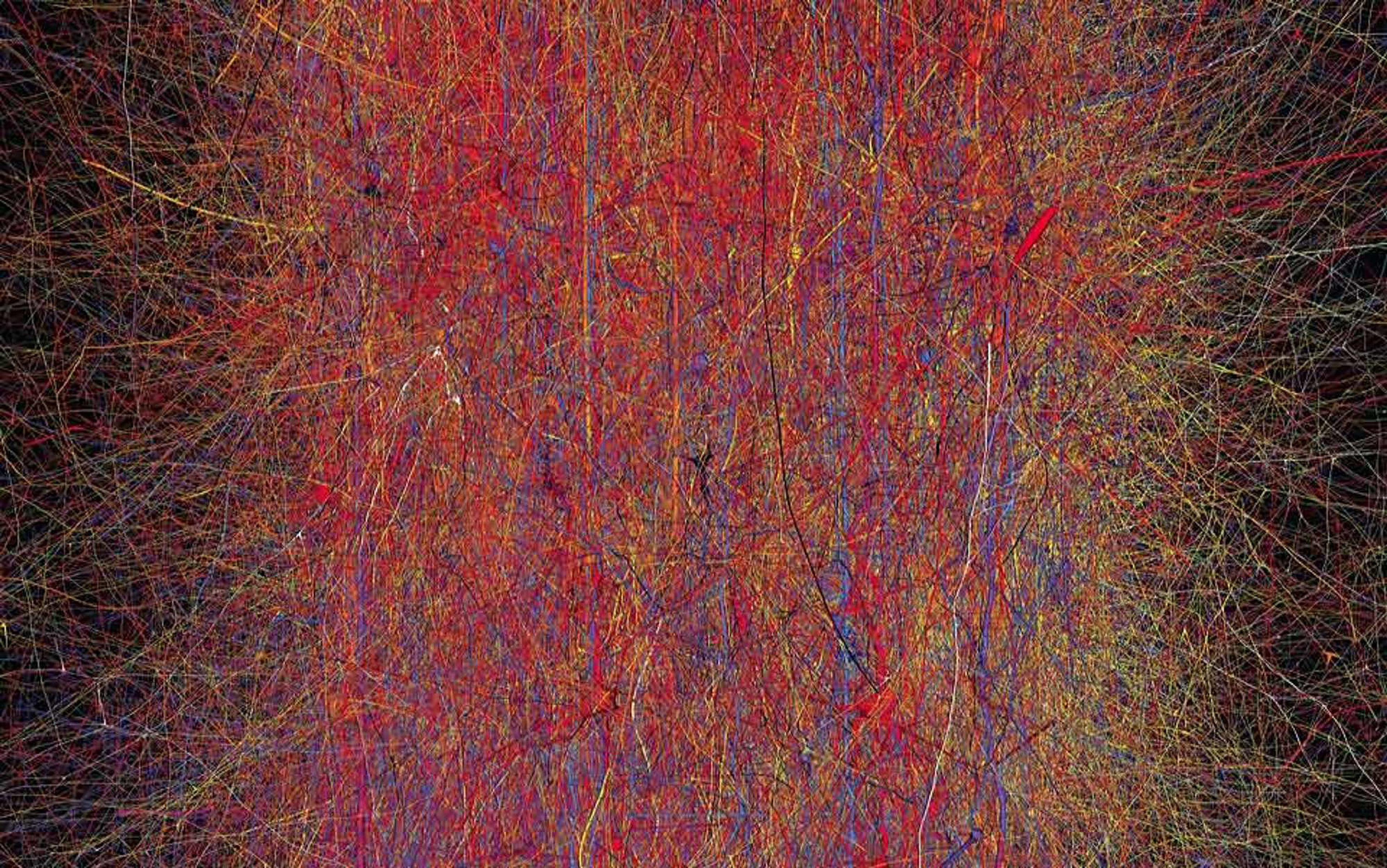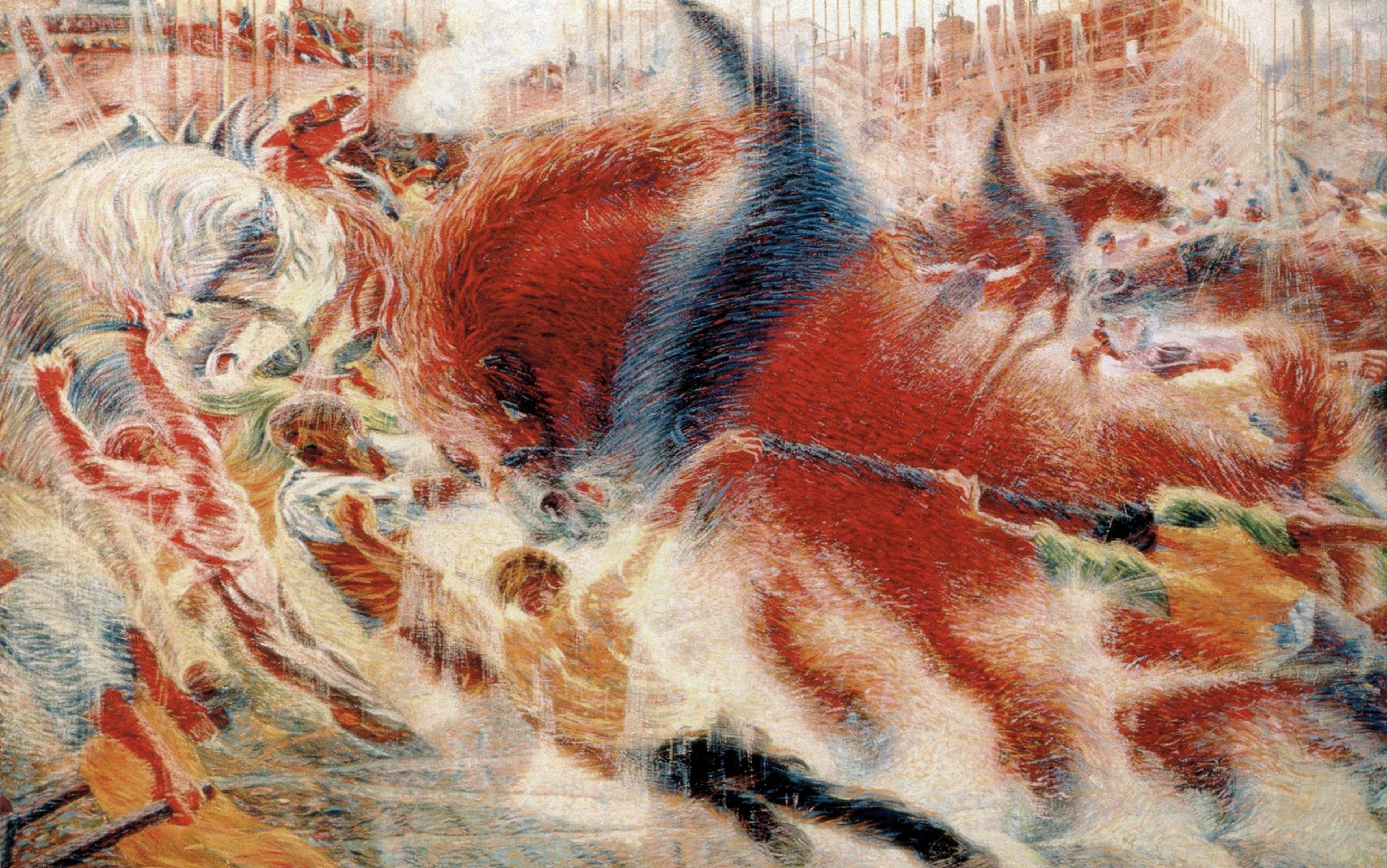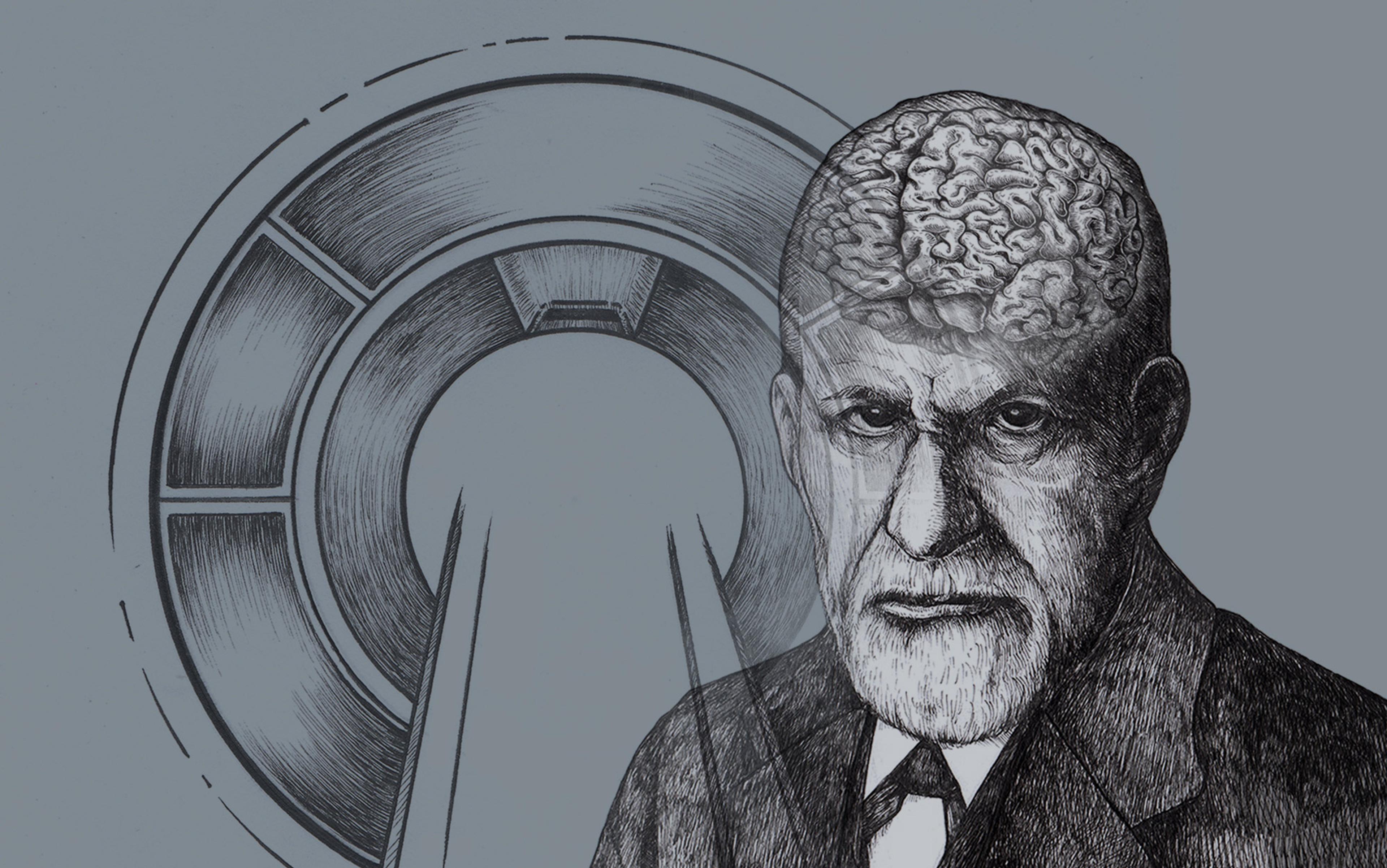Growing up in Australia, I loved to lie on the grass, immersed in the scent of wattles, and stare up at the sky. A sky like no other; a deeper, richer shade of blue than anywhere else I have been – and I’ve travelled on all seven continents, including Antarctica. Australians speculate that the colour of our sky results from its unusually thin ozone layer, a physical anomaly leading to sensory saturation.
Everyone agrees that the sky is blue, but how could I know that what I experience as blue isn’t what you experience as red? Philosophers have long been similarly perplexed. In An Essay Concerning Human Understanding (1690), John Locke wondered if ‘the same object should produce in several men’s minds different ideas at the same time; for example, the idea, that a violet produces in one man’s mind by his eyes, were the same that a marigold produced in another man’s, and vice versa.’ Now known to philosophers of mind as the inverted spectrum argument, Locke’s query points us to the mystery of subjective experience and its attendant problem of ‘consciousness’.
Objectively speaking, physicists have an explanation for what blue is. According to Maxwell’s equations, blue is ripples of electromagnetism with a wavelength of between 450 and 495 nanometres. A triumph of modern science, the wave understanding of colour allows us to determine the makeup of stars that are billions of light years away and assay the chemical compounds for their constituent elements. Yet the very success of this explanation highlights a conundrum; for while any spectrometer can register blue precisely on a dial, few of us would say that it is conscious. A spectrometer does not perceive blue. So what then, does it mean to be ‘conscious’ of colour?
First coined in 1995 by the Australian philosopher David Chalmers, this ‘hard problem’ of consciousness highlights the distinction between registering and actually feeling a phenomenon. Such feelings are what philosophers refer to as qualia: roughly speaking, the properties by which we classify experiences according to ‘what they are like’. In 2008, the French thinker Michel Bitbol nicely parsed the distinction between feeling and registering by pointing to the difference between the subjective statement ‘I feel hot’, and the objective assertion that ‘The temperature of this room is higher than the boiling point of alcohol’ – a statement that is amenable to test by thermometer.
It might seem surprising to many readers but, for 300 years, scientists and philosophers have been debating whether our minds might not operate more like Bitbol’s thermometer. Though Chalmers’ ‘hard problem’ term is new, the questions underlying it have haunted modern science from its beginnings, for the attribution of consciousness is one of the foremost qualities distinguishing us as something other than a complex set of dials.
As one of the founders of empiricism, Locke believed that knowledge comes primarily from sensory experience, with real knowledge being felt by conscious beings. In the 17th century, René Descartes had also insisted on the irreducible centrality of subjective experience, arguing that, in principle, we could not build a machine to emulate human behaviour. For Descartes, a conscious machine was an impossibility, and something extra – a soul – was needed to account for the full spectrum of our mental landscape and actions. Like Chalmers and Bitbol today, Descartes and Locke considered conscious experience as something that couldn’t be wholly explained by the laws of physical nature.
But in the early 18th century an emerging group of mechanists began to suggest that feelings and emotions were merely secondary byproducts of the ‘true reality’ of matter in motion. On this view, expressed by Julien Offray de La Mettrie in L’homme machine (1748), humans are essentially meat machines, complicated to be sure, but ultimately the same order of being as an expensive watch. The purpose of science was to discover the laws by which matter behaves, and thus the whole question of the conscious self – the ‘I’ that feels hot and blue – was not so much a problem as an irrelevancy.
The idea that the laws of nature might be able to account for conscious experience – a position known as physicalism – steadily gained supporters in the 19th century and was given a particular boost with the advent of Maxwell’s equations and other powerful mathematical frameworks devised by physicists in their golden age. If the invisible field of a magnet can result from natural laws, then might the same not be true for feelings?
Yet, as some philosophers of the early 20th century began to point out, physicalism contains a logical flaw. If consciousness is a secondary byproduct of physical laws, and if those laws are causally closed – meaning that everything in the world is explained by them (as physicalists claim) – then consciousness becomes truly irrelevant. Physicalism further allows us to imagine a world without consciousness, a ‘zombie world’ that looks exactly like our own, peopled with beings who act exactly like us but aren’t conscious. Such zombies have no feelings, emotions or subjective experience; they live lives without qualia. As Chalmers has noted, there is literally nothing it is like to be zombie. And if zombies can exist in the physicalist account of the world, then, according to Chalmers, that account can’t be a complete description of our world, where feelings do exist: something more is needed, beyond the laws of nature, to account for conscious subjective experience.
These are fighting words. And some scientists are fighting back. In the frontline are the neuroscientists who, with increasing frequency, are proposing theories for how subjective experience might emerge from a matrix of neurons and brain chemistry. A slew of books over the past two decades have proffered solutions to the ‘problem’ of consciousness. Among the best known are Christof Koch’s The Quest for Consciousness: A Neurobiological Approach (2004); Giulio Tononi and Gerald Edelman’s A Universe of Consciousness: How Matter Becomes Imagination (2000); Antonio Damasio’s The Feeling of What Happens: Body and Emotion in the Making of Consciousness (1999); and the philosopher Daniel Dennett’s bluntly titled Consciousness Explained (1991).
It has been said that, if the 20th century was the age of physics, the 21st will be the age of the brain. Among scientists today, consciousness is being hailed as one of the prime intellectual challenges. My interest in the subject is not in any particular solution to the origin of consciousness – I believe we’ll be arguing about that for millennia to come – but rather in the question: why is consciousness perceived as a ‘problem’? How exactly did it become a problem? And given that it was off the table of science for so long, why is it now becoming such a hot research subject?
Medieval theologians did not sit around debating the ontological status of zombies. They knew for a fact that humans are conscious and built a system of control and punishment around this principle. The Catholic Church tortured people for committing theological crimes over which they supposedly had conscious choice – the most salient being errors of faith: did one believe (as one should) in the Trinity of God, or in the heretical notion of Unitarianism? Torture was a method of mind control premised on a worldview in which conscious minds are morally accountable. Zombies, by contrast, have no real minds and no moral compass: they are neither good nor bad. Since they don’t feel pain in any meaningful sense, torturing a zombie would be pointless. What makes them such formidable foes on screen is that zombies are beyond the limits of subjectivity. We don’t feel for them because they don’t feel. Robots belong to the same order of being. Only when we think bots are developing consciousness (as in Blade Runner and Ex Machina) does our treatment of them become an issue.
Pain and suffering were very present aspects of the European mental landscape in the Middle Ages, and were graphically depicted in representations of Hell (think of Giotto’s Arena Chapel), thereby reminding would-be sinners of the torments awaiting them in the afterlife if they didn’t make the right moral choices here on Earth. For medieval Europeans, subjectivity extended beyond the grave. And that was the point. Self-awareness wasn’t an end in itself, it was a mechanism by which humans with their eternal souls were embedded in a cosmic scheme linking everything to an Ultimate Good. Heaven and Earth were two separate yet intertwined domains of human action. Medieval cosmology was thus inherently dualistic: the physical domain of the body had a parallel in the spiritual domain of the soul; and for medieval thinkers, the latter was the primary domain of the Real.
You could literally read the moral status of people in medieval images by their scale. Jesus would be drawn as the largest figure because he had the greatest moral stature; next came angels who were somewhat smaller, followed by saints and martyrs, then ordinary humans. Smallest of all were the sinners in Hell who, in Giotto’s rendition, are minute figures focused in their pain, hemmed in by their puny morals. In contrast with the bleakness and blackness of Hell, Heaven was often portrayed in a gorgeous shade of blue, achieved through costly pigments containing ground lapis lazuli and other precious stones that metaphorically signalled the value of redemption. Blue, here, was the wavelength of God.
When modern science swept away this dualistic symbolic schema, Europeans came to see themselves as inhabitants of a Euclidean void: we lived on a planet that orbited an insignificant star in potentially infinite space. As described by geometry and physics, this space was understood to be controlled by mathematical laws. And, in this despiritualised, Euclidean space, human figures, including Christ and the saints (now equally subject to natural law) were necessarily depicted at the same scale. The homogeneous, featureless Euclidean void, which forms the backdrop to Galilean and Newtonian science, has its visual correlate in the homogeneous scheme of perspectival representation that unified earthly and heavenly space. Now all objects were placed within a single frame of reference. Perspective, delightfully known in the 13th century as ‘geometric figuring’, enabled artists to simulate the illusion of physical depth, but it removed the metric by which they had previously represented moral depth. Just as art became literal rather than iconic with the advent of modern science, our concept of a moral universe became subject to homogenisation, and finally to a kind of erasure.
Once we take our universe to be a mathematical arena, a question arises as to where in this scheme the realm of the soul might be found. Specifically, in an infinite despiritualised Euclidean universe there is no room for Heaven. Indeed it now becomes problematic to talk about any place beyond the physical realm. This hadn’t been an issue with the medieval cosmos, which was finite. As depicted in pre-Renaissance imagery, the medieval cosmos was a relatively small place, with the Earth at the centre surrounded, onion-like, by a set of concentric spheres carrying the Sun, Moon, planets and stars. Beyond the outermost sphere of the stars, there was metaphorically plenty of space left for the Empyrean Heaven of God. At the end of The Divine Comedy (1320), when Dante reaches the end of the physical world, he pierces the cosmic skin and emerges into the presence of ‘the Love which moves the sun and the other stars’. But with the arrival of the Newtonian universe, the problem of Heaven’s ‘location’ was compounded into a geographical absurdity.
the baby of personal experience and conscious moral accountability was thrown out with the bathwater of the soul
And if there was no place for Paradise, then there was no place for a soul to go after death. In the end, did one even need a soul to make sense of the human condition? If the condition of the world is mathematical, and the space of reality is geometric, then can’t we dispense with the spiritual stuff and just get on with the business of plotting our co‑ordinates in Euclidean space, refining in ever more detail the ‘laws’ that operate within it?
Thus was born materialism, which viewed humans as purely physical objects made up of component parts moving in space according to mathematical laws. De-souled, stripped of a cosmic connection to God, humans became sub-units of the world-machine. The business of science was to ascertain the rules by which this machine-world works – the objective ‘laws of nature’ – and the whole question of subjectivity was heaved out the door. In a sense, the baby of personal experience and conscious moral accountability was thrown out with the bathwater of the soul.
Although full-blown materialism (an early variant of physicalism), wasn’t articulated until the 18th century, its shadow was already hovering in Galileo’s 17th-century distinction between objective and subjective qualities. In his book The Assayer (1623), Galileo wrote: ‘If ears, tongues, and noses were removed, I am of the opinion that shape, quantity and motion would remain, but there would be an end of smells, tastes, and sounds.’ Shape, quantity and motion – these were not only the objects of science, they were the primary reality. In Galileo we witness a quantum leap forward in the practice of science, but perhaps, even more monumentally, we see in his thinking the dawning of a new attitude to the question of what reality is.
Here was presaged a future that Descartes had struggled to avoid. For while Descartes championed mathematical science as a way forward for understanding the physical world, as a Catholic, he also insisted on the reality of the Christian soul. Hence his famous dualism, with its two domains of being: the res extensa (the extended realm of matter in motion), and the res cogitans (the realm of thoughts, feelings, emotions and moral action). Descartes wanted to preserve the essence of medieval dualism while simultaneously opening up a space for mathematical science. This was his special genius; he invented co-ordinate geometry (enabling us to better navigate inert Euclidean space), yet at the same time he attempted to ‘save’ the phenomenon of the soul.
Galileo, his near contemporary, had little interest in the soul. It’s one reason his writing still feels so modern. Like Descartes, Galileo wrestled with the question of what a new science could be and what aspects of reality such a science could describe. But where Descartes would have been horrified by the notion of subordinating subjectivity under the banner of science, Galileo remained agnostic. In The Assayer, he wrote: ‘Concerning sensation and things that pertain to it, I claim to understand but little. Therefore I leave it unsaid.’
For most of the history of modern science, subjectivity has been left unsaid – a topic hovering beyond the reach of equations and test-tubes. Why then has it now sprung so strongly to the forefront of scientific thinking?
Physicists and chemists might not have been thinking much about subjectivity during the 18th and 19th centuries, however lots of other people were. The development of psychoanalysis in the late 19th century can be understood in this context; whatever we might think about the specifics of Sigmund Freud’s theories, as emotional beings we can applaud his desire to offer a systematic approach to the understanding and healing of our psyches. It has been argued that one way of interpreting The Divine Comedy is as a medieval version of psychoanalysis – not only the theological journey of a soul toward redemption, but also the therapeutic journey of a sick mind toward psychic health. Heaven and hell aren’t only Christian places: they are also states of mind. Whatever our bodies are doing in physical space, we also inhabit psychic space and we need ways to talk about the states that minds are in.
Artists, too, attempted to tackle subjectivity head-on, with impressionism, surrealism and expressionism. These movements excite us precisely because they manifest, and at the same time interrogate, the deeply subjective perspective of the artist-observer. We love seeing the world through the eyes of Vincent van Gogh and Paul Cézanne because they are individuals with their own imaginative landscapes, and because their work (van Gogh’s green skies, Cézanne’s fractured Cubist landscapes) challenges the idea that objective reality is somehow more true than its subjective counterpart. Earlier this year, a painting by Paul Gauguin sold for an estimated $300 million. One reason the art market is so insane is that art has come to represent the power of the individual perspective and, rightly or wrongly, lots of people see it as an antidote to the de-subjectification of science.
Of course, literature has always given us subjective impressions of the world, and the rise of the modern novel, again when science was doubling down on its commitment to physicalism, testifies to an emerging appetite to become immersed in other people’s minds. Henry James, Marcel Proust and Franz Kafka propel us into the unique sensibilities of their protagonists. James, whose writing has been likened to a literary version of impressionism, was deeply interested in representing the consciousness of his characters, while his brother, the psychologist and philosopher William James, gave us the term ‘stream of consciousness’ to describe the flow of thoughts, feelings and ideas that ramble through our minds. James coined this term in his book The Principles of Psychology (1890), and in the early decades of the 20th century it came to be associated with such quintessentially modernist writers as James Joyce.
But perhaps most surprisingly, just when the ‘stream of consciousness’ was entering our lexicon, physicists began to realise that consciousness might after all be critical to their own descriptions of the world. With the advent of quantum mechanics they found that, in order to make sense of what their theories were saying about the subatomic world, they had to posit that the scientist-observer was actively involved in constructing reality. At the subatomic level, reality appeared to be a subjective flow in which objects sometimes behave like particles and other times like waves. Which facet is manifest depends on how the human observer is looking at the situation.
Such a view appalled many physicists, who fought desperately to find a way out, and for much of the 20th century it still seemed possible to imagine that, somehow, subjectivity could be squeezed out of the frame, leaving a purely objective description of the world. Albert Einstein was in this camp, but his position hasn’t panned out. Forty years ago, the American theoretical physicist John Wheeler proposed a series of thought experiments to test if an observer could affect whether light behaved as a particle or a wave and, in 2007, the French physicist Alain Aspect proved that they could. Just this April, Nature Physics reported on a set of experiments showing a similar effect using helium atoms. Andrew Truscott, the Australian scientist who spearheaded the helium work, noted in Physics Today that ‘99.999 per cent of physicists would say that the measurement… brings the observable into reality’. In other words, human subjectivity is drawing forth the world.
Not all physicists are willing to go down this path, however, and there is indeed now a growing backlash against subjectivity. That has brought into being the so-called ‘many worlds interpretation’ (MWI) of quantum theory. According to this interpretation, every time a subatomic particle is confronted with options – does it do X, or does it do Y? – the Universe splits into two identical copies of itself, in one of which the particle does X and in the other it does Y. Given that physicists estimate that there are around 1080 subatomic particles in our Universe, and most of them are confronted with options many times a second, it means that, according to MWI, gazillions of copies of our universe are sprouting off one another every nanosecond.
This fissiparous seething is one of the few ways to interpret quantum behaviour without awarding consciousness a central role, and when I was a physics student the MWI was widely seen as a fringe concept. Today, it is becoming mainstream, in large part because the pesky problem of consciousness simply hasn’t gone away.
Some physicists want to be rid of the problem of consciousness altogether, while others are attempting to treat it as a core material phenomenon. Max Tegmark, a theoretical physicist at the Massachusetts Institute of Technology, for example, hopes that consciousness will turn out to be another state of matter, like a solid, liquid or gas, and he’s calling for physicists to begin exploring the ‘physical correlates of consciousness’. What, he asks, are the physical conditions that pertain when consciousness is present?
Hildegard might well have been an epileptic: that didn’t mean God wasn’t also talking to her
There are parallel moves in neuroscience to determine the ‘neural correlates of consciousness’ (NCC) – the neurological signatures of awareness. Originally developed in the 1990s by the American neuroscientist Christof Koch and the British Nobel laureate Francis Crick, the NCC project has been making massive strides; tools such as fMRI and optogenetics are now enabling us to see what neurons are doing when we think certain thoughts. Moreover, projects such as the BRAIN initiative in the US and the European Union’s Human Brain Project are mapping what parts of the brain are active while people experience a vast range of emotions and mental experiences.
This is all thrilling science, yet a question remains: will any of it explain subjective experience? Chalmers, the philosopher, claims that the problem of experience is not mechanistically reducible and he argues that it will ‘persist even when the performance of all the relevant functions is explained’. In other words, he says, no amount of detail about neuronal potentials and interconnection is going to get us to the essence of subjectivity.
Plenty of neuroscientists, physicists and philosophers disagree with him, but I’m on his side. What’s at stake here is far more than the issue of whether your experience of blue is the same as mine, because subjectivity also has a moral dimension, as Descartes and the medievals understood. Locke pointed to this as well when he defined the human self as ‘that conscious thinking thing, (whatever substance, made up of whether spiritual, or material, simple, or compounded, it matters not) which is sensible, or conscious of pleasure and pain, capable of happiness or misery, and so is concerned for itself, as far as that consciousness extends’.
Here again we meet the subject of pain, both physical and emotional. Can misery be ‘explained’ by synaptic firing? Can happiness? Some years ago, I discussed this issue with Father George Coyne, a Jesuit priest and astronomer who was then Director of the Vatican Observatory. I asked him what he thought of the notion that when the 12th‑century Hildegard of Bingen was having her visions of God, perhaps she was having epileptic fits. He had no problem with the fits. Indeed, he thought that when something so powerful was going on in a mind, there would necessarily be neurological correlates. Hildegard might well have been an epileptic, Father Coyne opined; that didn’t mean God wasn’t also talking to her.
Pain is surely like this too: it must have neurological correlates otherwise we wouldn’t be able to react to withdraw a hand from a flame and save our bodies from damage. (People who lose the ability to feel pain quickly succumb to injuries.) At the same time, pain transcends its physical dimensions, as do the many species of misery catalogued in Dante’s Hell, and represented to us in daily news accounts of the effects of war on millions of people today.
Giulio Tononi’s book Phi (2012) asks the question: ‘How could mere matter generate mind?’ As a neuroscientist, Tononi says this is a mystery ‘stranger than immaculate conception… an impossibility that defie[s] belief’. Nonetheless, he offers us an explanation of consciousness grounded in information theory that has been admired by both Tegmark and Koch. He wants to do for psychic phenomena what Descartes, Galileo and their heirs did for physical phenomena: he wants to explain subjective experience by generalised empirical rules, and he tells us that such experiences have shapes in a multidimensional mathematical space.
Personally, I don’t have a problem with the idea that subjective experiences might have mathematical correlates any more than Father Coyne minds the notion of neural correlates. As an admirer of co-ordinate geometry, I like Tononi’s concept; at the same time, I don’t accept information theory as a bridge to subjectivity.
Neurological and informatic models of subjectivity will no doubt have their uses and values, as did mechanistic models of the world before them. Yet, like their mechanistic forebears, these theories are grounded in an insistence that subjectivity is a secondary phenomenon whose explanation resides in something prior. Chalmers wants to insist, along with Descartes and Locke before him, on the primacy of subjective experience or, as the philosopher Bitbol puts it, ‘that consciousness is existentially primary’. Rather than being something that can be ‘described by us in the third person as if we were separated from it’, Bitbol argues that consciousness ‘is what we dwell in and what we live through in the first person’. This feels reminiscent of what the German philosopher Edmund Husserl in 1936 called the ‘life-world’ of conscious experience, and I suspect that it is where we must look to locate the source of our selves. But I also expect that philosophers and scientists will be arguing the point for centuries to come.






